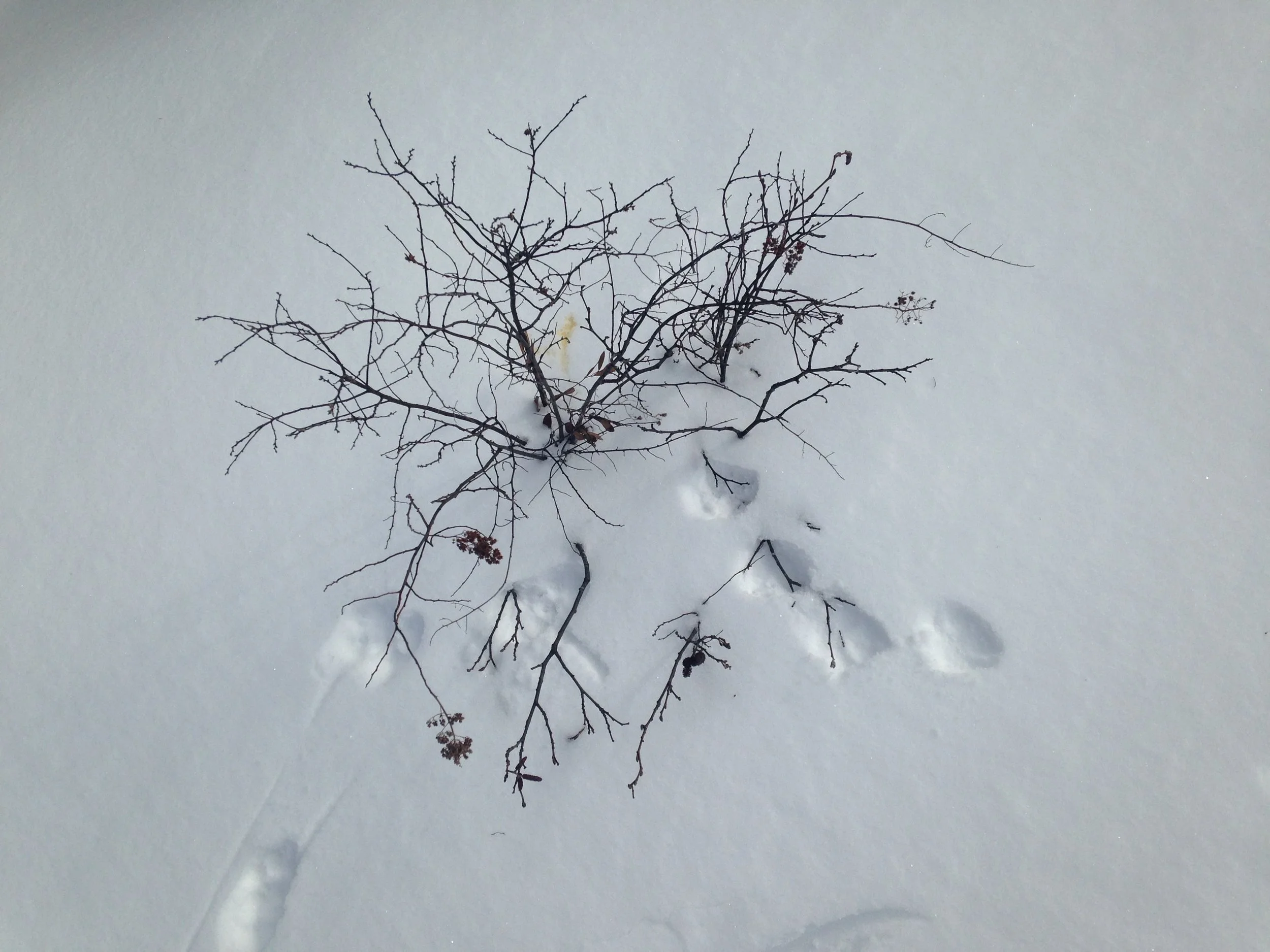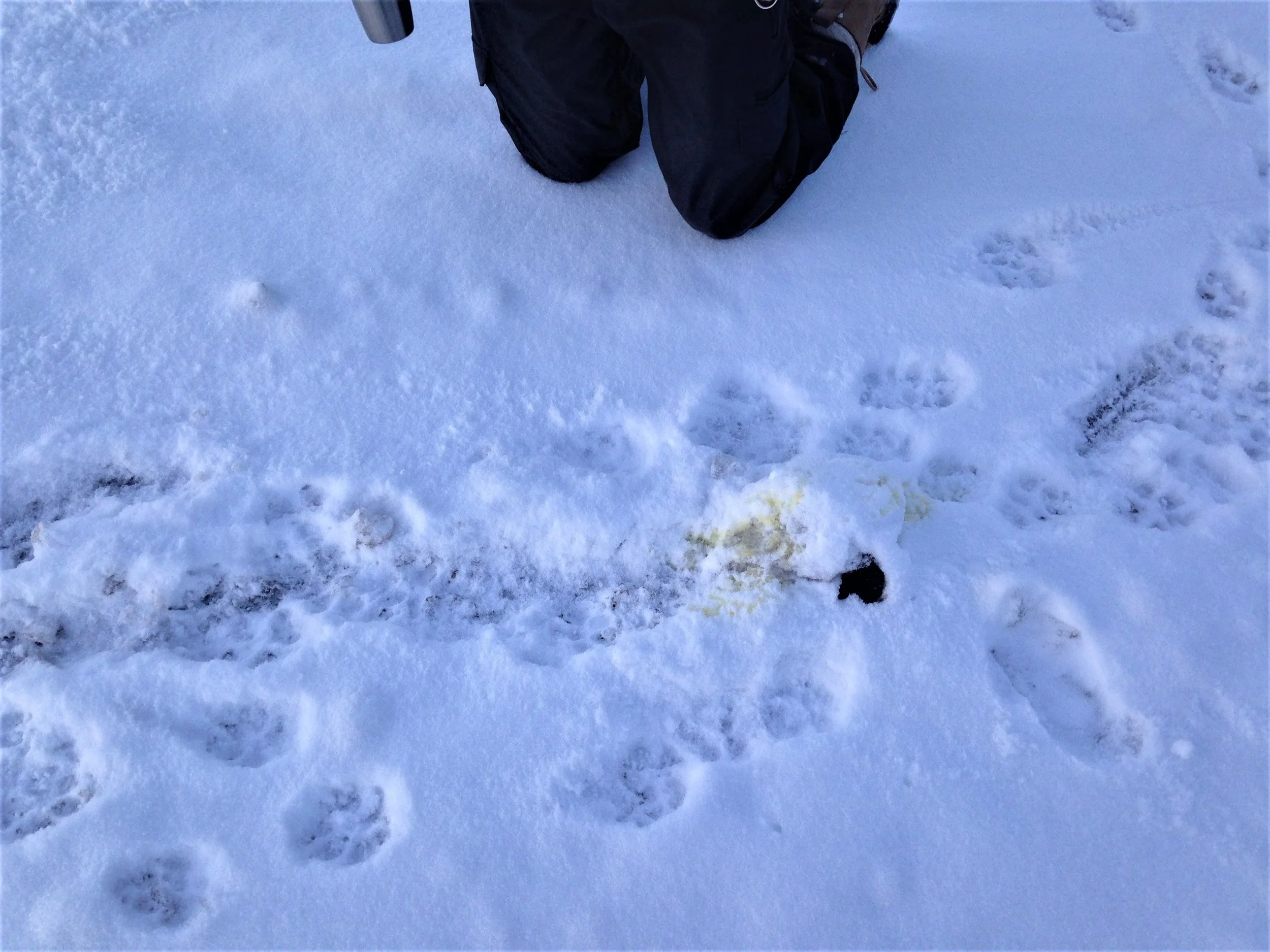Are There Dangers In Smelling Red Fox Urine?
Male Red Fox (Vulpes vulpes) trail leading up to and away from Speckled Alder (Alnus incana) shrub. Note urine scent mark seen in the snow behind. 2023.02.12
Recently, while trailing in Algonquin Park with the Earth Tracks Wildlife Tracking Apprenticeship some of us bent down on different occasions to smell Eastern Timber Wolf/Algonquin Wolf (Canis lycaon), Red Fox (Vulpes vulpes), and River Otter (Lontra canadensis) scent marks, which were usually small deposits of urine placed in a prominent spot along the animal’s trail. When we got back to the Wildlife Research Station which was our home base for the weekend, we got to talking about safety around sniffing animal urine when trailing.
Personally, I have smelled animal urine literally hundreds of times. Nearly every time I see a urine deposit on an animal trail, aside from Human (Homo sapiens) and other domestic animals, I get down and sniff. But the questions got me reflecting; When tracking or trailing an animal, are there dangers in smelling animal urine?
In the winter, when trailing Red Foxes I tend to bend down and check out scent marks on the trail as an additional way to confirm that I am following the animal I think I am. I will look to the track size, stride length, general habit of the trail, the habitat and location in the world, but also the specific scent will also help in the identification and ecology of the animal being followed, especially this time of year. In late-Summer and Autumn, male Red Foxes will scent mark more than females, as well as in March when the females are denning with new kits, but in the Winter both sexes scent mark with urine fairly equally. That’s because up until a couple of weeks ago, Red Foxes were in the climax or tail end of their breeding season. This also means the urine they left behind was especially pungent. Urine and the chemicals secreted into the urine from internal glands create complex signals to let other Red Foxes, and likely other animals, know who is who, where they have been, who they are hanging out with, how healthy they are, and if they are mated or ready to mate. While Wolves are different animals, there is a study (Mech et al, 1987) into Grey Wolf (Canis lupus) urine where researchers collected samples of urine to determine how well fed individual Wolves were within a pack. They also tested the urine to see how well the pack was eating. I infer, with their highly advanced olfactory perception, Canids of all sorts can pick up tons of information just from smelling each others pee.
While some folks can smell this urine from a few meters away, others, sometimes including myself need to get up close to get a good whiff of it. This is when folks often get anxious. Should we be bending down low and smelling Fox urine? What about disease or pathogen spread? What are the dangers?
Hugh on his knees about to smell an Algonquin Wolf (Canis lycaon) scent post @ Mizzy Lake, 2023.02.11
There seems to be uncertainty around exposure to diseases through simply smelling urine. While one book (Henry, 1993) notes “[i]t is perfectly safe to put your nose 4 - 6 in (10 - 15 cm) of a Fox urine mark and smell for the characteristic odor”, it should be noted that there is a disease caused by the genus of bacteria Leptospira. The disease is known as Leptospirosis, which is the most widespread zoonotic disease in the world, and it is commonly spread through contaminated water. Water is contaminated by either domestic or wild animals urinating in the water, or close to water sources. Leptospirosis is spread to humans when we spend time in open water like still ponds, stagnant rivers, slow creeks, and especially after rains and heavy floods. It also tends to occur more in warmer weather, and while it is cosmopolitan in distribution (occurs all over the world), Leptospira transmission occurs more often in the tropics (is this because of access to clean water or due to consistent warmer temperatures?). Infections occur when bacteria enter through cuts in the skin, the mouth, nose and eyes and can present as asymptomatic or…
Symptoms can appear 2 days to 3 weeks after contact with the bacteria.
Common symptoms may include fever, headache, chills, nausea, vomiting, diarrhea, muscle pain, skin rash and eye infection.
In more severe cases, symptoms may worsen to include jaundice (yellowing of the skin and eyes), kidney and/or liver failure, inflammation of the heart muscle and meningitis. The severe form of leptospirosis is known as Weil's disease.”
When Humans are infected, they are often treated with antibiotics although the disease can also clear up without the use of corrective measures. Infections can be higher among other domestic animals like Cows (Bos taurus), Horses (Equus ferus caballus) and Sheep (Ovis aries), but other animals who interact with humans can also occasionally be infected. Rodent hosts, notably Rats (Rattus spp), are probably the most common species with the highest rates of infection in close proximity to humans.
While Leptospirosis spreads more with species which gather, or are held in large, closely confined herds like the Cows and Sheep mentioned above, species like Red Foxes are more solitary and do not travel in packs. Even Eastern Coyotes (Canis latrans) and Algonquin Wolves pack sizes are much smaller than Sheep or Cows, usually between 2-4 adults for the Coyotes, and 3-6 adults for the Wolves. With these small group sizes, who occupy large home ranges the chance of infection and spread is greatly reduced.
With all of this in mind, again it is important to remember that it is highly unlikely that we will be in any direct relationship with this bacteria and that “the risk of infection from free-ranging, wild animals is virtually non-existent.”
So, I would suggest getting down, 10 - 15 cm away if being cautious, and sniffing some Red Fox urine while they trot around showing off how cool they may be and how big and lovely their territories are. It’s worth the experience, and the memory associated with the scent will help with identification into the future.
Update : 2023.03.23 : Big thanks to Sarah Helman, lead author of “Pathogenic Leptospira are widespread in the urban wildlife of southern California” for answering some additional questions I had and for checking out this article and pointing our some statements that I had written that weren’t backed up by the research. I am so grateful when folks who know can point out things to me where I can learn something. I appreciate it a lot. Thanks Sarah!
To learn more :
Safety Data Sheet for Red Fox Urine
Seasonal and sex differences in urine marking rates of wild red foxes Vulpes vulpes by Fawcett, J.K., Fawcett, J.M. & Soulsbury, C.D. J Ethol 31, 41–47 2013.
How To Spot A Fox by J. David Henry; Chapters, 1993
Animal Diseases by The United States Department of Agriculture, 1956.
Government of Canada infopage on Leptospirosis
Michigan Department of Natural Resources page on Leptospirosis
Pathogenic Leptospira are widespread in the urban wildlife of southern California


